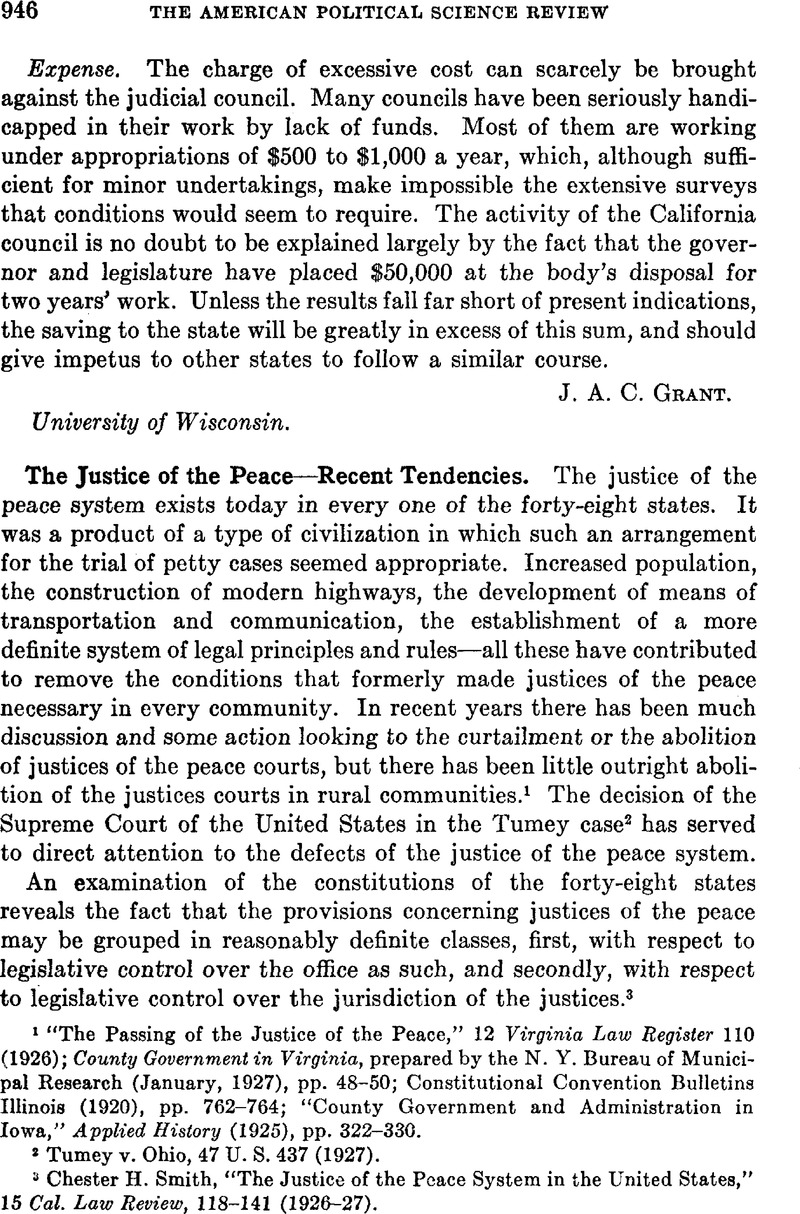No CrossRef data available.
Article contents
The Justice of the Peace—Recent Tendencies
Published online by Cambridge University Press: 01 August 2014
Abstract

- Type
- Notes on Judicial Organization and Procedure
- Information
- Copyright
- Copyright © American Political Science Association 1928
References
1 “The Passing of the Justice of the Peace,” 12 Virginia Law Register 110 (1926)Google Scholar; County Government in Virginia, prepared by the N. Y. Bureau of Municipal Research (January, 1927), pp. 48–50Google Scholar; Constitutional Convention Bulletins Illinois (1920), pp. 762–764; “County Government and Administration in Iowa,” Applied History (1925), pp. 322–330Google Scholar.
2 Tumey v. Ohio, 47 U. S. 437 (1927).
3 Smith, Chester H., “The Justice of the Peace System in the United States,” 15 Cal. Law Review, 118–141 (1926–1927)CrossRefGoogle Scholar.
4 Ariz., Ark., Del., Fla., Ga., Idaho, Ill., Kans., Ky., Md., Mich., Minn., Miss., Mo., Mont., Nev., N. Mex., N. C., Okla., Oregon, S. D., Tenn., Texas, Utah, Wash., W. Va., Wis., Wyo.
5 California.
6 Ala., Colo., Conn., Iowa, Ind., Me., N. H., N. Y., Ohio, Pa., R. I., S. C, Vt.
7 La., Neb., N. J., N. D., Va. The North Dakota constitution (1913), Sec. 112, reads: “The legislative assembly shall have power to abolish the office of justice of the peace and confer that jurisdiction upon judges of county courts or elsewhere.” The Massachusetts constitution (1780) contains provisions with reference to tenure of office (Ch. 111, Art. iii) and removals (Amends., Art. XXXVII) of justices of the peace, and nothing more. On jurisdiction, see 3 Pick. (Mass.), 508 (1827).
8 Ala., Ark., Fla., Ga., Ia., Miss., N. M., N. C., N. D., Tex., W. Va., Wyo.
9 Ariz., Cal., Colo., Idaho, Mich., Minn., Mont. Neb., Nev., N. H., S. C., S. D., Utah.
10 Conn., Del., Ill., Ind., Kans., Ky., La., Md., Mo., N. J., Okla., Ore., Pa., R. I., Tenn., Va., Wash., Wis.
11 The office is created by constitutional provision, but with no provision for jurisdiction, in Maine, Mass., N. Y., Ohio, Vt.
12 California Code of Civil Procedure (1915), Sec. 102(b).
13 “The Constitutionality of Fee Compensation for Courts,” 36 Yale Law Jour., 1171–75 (1926–1927)Google Scholar.
14 Louisiana constitution (1921), Sec. 50; South Carolina constitution (1895), Art. V, Sec. 20.
15 Smith, Reginald H., Justice and the Poor (N. Y., 1919)Google Scholar.
16 Tumey v. Ohio, 47 U. S., 437, decided March 7, 1927.
17 Laws of Ohio, 1927, p. 269.
18 Committee on Establishment of Uniform Inferior Courts.
19 Constitution of Ohio (1851), Art. 4, Sec. 9, as amended Sept. 3, 1912.
20 Constitution of Virginia (1902), Sec. 108.
21 General Laws of Virginia, 1923, Ch. 81.
22 Virginia Code, 1924, Secs. 4988–4988 (29).
23 Acts of Virginia Assembly, 1926, Ch. 511.
24 Laws of Kansas, 1927, Ch. 180.
25 Ibid., Ch. 182.
26 In re Greer (1879), 58 Kans. 268, 48 Pac. 950, the constitutionality of a similar statute was upheld. But see contra, St. ex. rel. Burke v. Hinkel (1911), 144 Wis. 444, 129 N.W. 393.
27 Laws of Mississippi, 1926, Ch. 131.
28 Biennial Report of the Secretary of State of Mississippi (1926–27), pp. 156–157 (figures are as of May 31, 1927).
29 Wisconsin Statutes, 1927, Vol. 1, Chs. 253 and 254; Laws of Wisconsin, 1909, Ch. 549; Laws of Wisconsin, 1913, Ch. 702.
30 Laws of Maryland, 1927, pp. 521–530.
31 Chap. IV, Sec. 81.
32 Revised Laws of Hawaii, 1925, Vol. 1, Chs. 14 and 137.



Comments
No Comments have been published for this article.